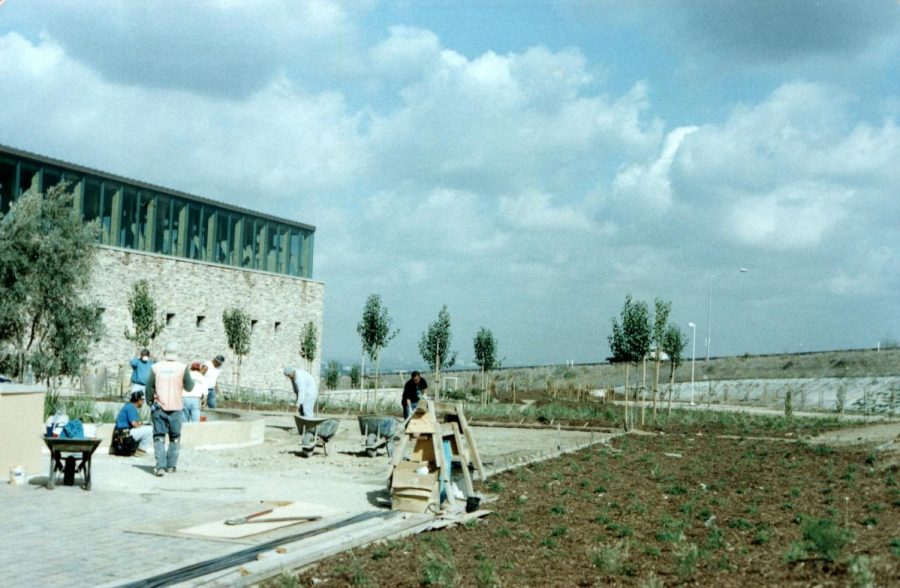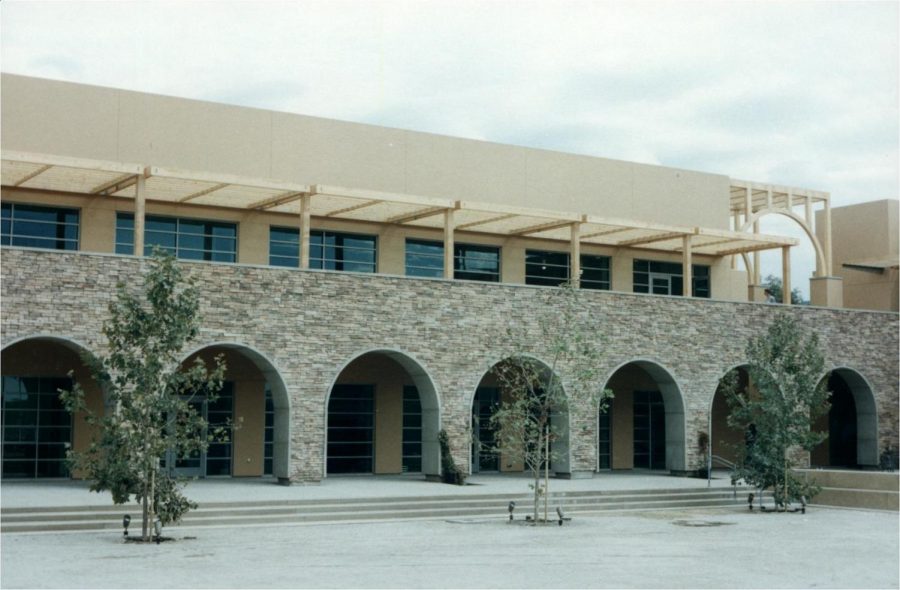Then and Now at Sage Hill
As Sage celebrates its 20th year, we reflect on both the many changes and its constant core values.
This is what Wilkins Town Square looked like shortly after construction of Sage Hill School in 2000. The trees back then were freshly planted, and now they tower above the students and provide some shade as they sit in Town Square for lunch or Town Meetings.
September 9, 2019
Twenty years is a long time for anything. It’s the transformation period from lolling infant to college student, equivalent to the collected lifespans of two hundred sixty common houseflies.
Sage Hill enters its third decade and welcomes its 20th class this year, entering a new moment when the school itself is older than many of its students. We’re all offered the opportunity to reflect on how things have changed, and take advantage of the possibilities the next twenty years have to offer.
The mythology of Sage Hill School marks its origins in the mid-1990s, when a group of visionary parents and educators decided to create a top-tier independent high school to nurture students, push them forward, grow their skills and allow them to succeed in the real world. The school opened in September of 2000, with a freshman class of 90 students and 30 sophomores.
From these humble beginnings, Sage only moved upward. The Studio at Sage Hill was added in 2009, complete with the Black Box Theater and spaces built for dance, choir, band, and visual arts. This building cemented the school’s commitment to both arts specifically and the student experience at large.
The science complex, built in 2014, was another major milestone in the school’s growth, creating 13,000 square feet of lab space for Sage’s science students. Six tennis courts and the swimming pool, added in 2016 and 2017, enhanced the school’s sports offerings and transformed Sage into not just an academic powerhouse but also an athletic one.
Many students are quite happy about the most recent renovation, last year’s overhaul of the Johnson Family Library. The modernization added a number of small hangout nooks, made the upper library much more open and expansive and a new upstairs conference room, the McNeill Merz Loft.
“[I] love it,” said senior Rohun Krishan. “The library remodel is awesome, and what’s even more awesome is how they let us eat lunch there now.”
Amid all this dynamic growth, and the explosion of the school size to approximately 550 students split across four grades, Sage has held remarkably consistent in the elements that really matter. “Sage Culture,” an esoteric, elusive ideal that represents the inclusivity, drive, passion and growth-oriented ethos woven into the fabric of Sage Hill, continues to inform student experiences. The six Cs (Character, Collaboration, Community, Creativity, Critical Thinking, and Cross-Cultural Competency, for our freshman readers) are alive and well.
The success of Sage Culture is in large part due to the students and faculty who live it, taking each day.
“Sage Hill’s culture is created and maintained by our students. I always appreciate how our students are dedicated to making our campus a warm, welcoming and accepting environment for everyone,” Head of School Patricia Merz said. “Each year the culture evolves in ways that reflect the personalities, spirit and interests of our community.”
Another trend that’s stayed constant is the approach to teaching: formulated as a place to learn how to learn, Sage and its faculty focus on helping students critically analyze topics or synthesize information, enabling an excellent learning environment for students at Sage.
“What’s remained constant is the quality of our faculty, because they try to be part of the class environment, mentors and guides rather than mere instructors,” said Sage President Gordon McNeill. “A lot of classes run using the Socratic method of asking lots of questions back and forth, of having discussions and debates, and that philosophy has been at Sage since Day One.”



